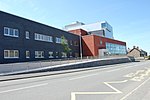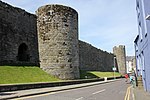Afon Seiont

Afon Seiont (Welsh, meaning River Seiont in English) is a river in Gwynedd, Wales which runs into the Menai Strait. Its source is the outflow of Llyn Padarn near Llanberis, and it flows out in a generally northwest direction. Between the outflow and the village of Llanrug it is known as the Afon Rhythallt, changing its name just after the village. Its mouth is in the town of Caernarfon, forming a natural harbour as it flows out into the Menai Strait. The Afon Nant Peris provides the main inflow into Llyn Peris which then drains into Llyn Padarn with the addition of the waters of the Afon Arddu which drains the northern slopes of Snowdon. The name of the Roman fort of Segontium, near Caernarfon, is based on the Latinised form of the name 'Seiont'. In the Brythonic language *seg-ontio translates as "strong place".
Excerpt from the Wikipedia article Afon Seiont (License: CC BY-SA 3.0, Authors, Images).Afon Seiont
Gerddi Menai,
Geographical coordinates (GPS) Address Nearby Places Show on map
Geographical coordinates (GPS)
| Latitude | Longitude |
|---|---|
| N 53.15 ° | E -4.2666666666667 ° |
Address
Gerddi Menai
Gerddi Menai
LL55 1LN , Caernarfon
Wales, United Kingdom
Open on Google Maps








